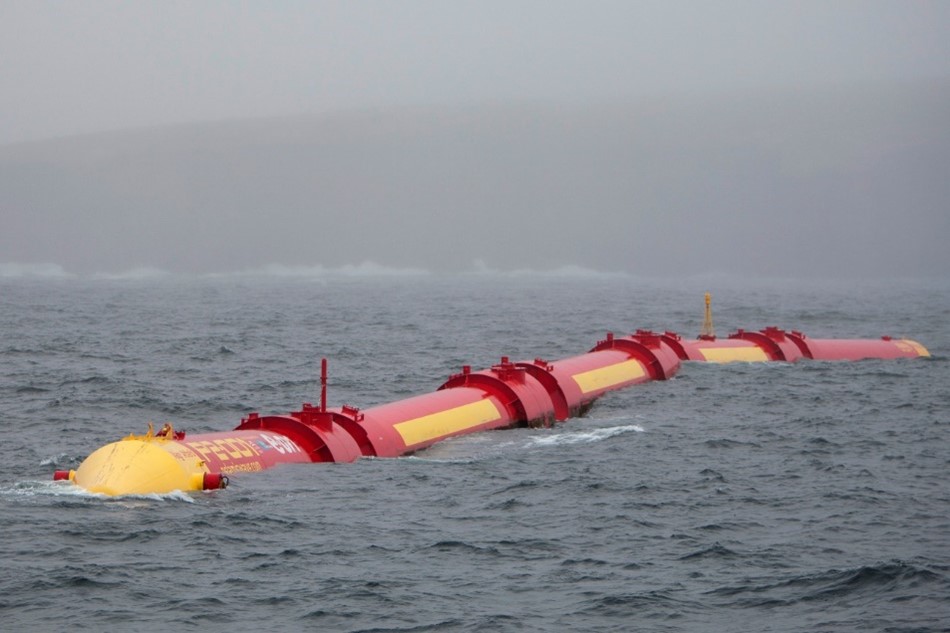
Since its installation in 2019, the WaveRoller wave energy farm in Peniche, Portugal, generates electricity from wave power and delivers it to the Portuguese national grid. Photo: AW-Energy Oy
The urgency to reduce greenhouse gas emissions and slow down climate change from human causes has made renewable energy a popular topic of discussion.
From solar panels to wind turbines, numerous clean energy sources are being explored to transition away from fossil fuels. With the world’s oceans covering more than 70% of the planet, it’s not surprising that wave energy is being explored as a potential solution to our energy needs. On our “blue planet”, the motion of waves could hold the key to reducing our carbon footprint and creating a sustainable future.
Wave energy uses the power of ocean waves to generate electricity.
Waves can deliver a strong force – if you, like me, are used to swimming in the sea, you might especially know this!
Capturing even a small fraction of that kinetic energy, which is energy from motion, could make a significant contribution to the world’s renewable energy mix. In recent years, advances in technology have made wave energy more accessible and cost-effective. There are now a variety of wave energy devices on the market, ranging from floating buoys to underwater turbines, each with its own unique advantages and drawbacks.
According to the World Economic Forum (WEF), wave energy could play a vital role in meeting the world’s energy demands. However, the adoption of this renewable energy source has been slow due to technical challenges such as system reliability and high costs. Nonetheless, recent advances in technology have allowed the development of more efficient wave energy converters, making it a more viable option for energy production.
Governments around the world, including the UK, Australia, and Canada, are supporting the development of wave energy through funding and policy initiatives.Furthermore, as per the WEF, experts from the International Energy Agency and the European Marine Energy Centre predict that wave energy could contribute up to 10% of the world’s electricity by 2050, highlighting the potential of this renewable energy source to help combat climate change.
In 2021, scientists at RMIT University, in Australia, created a device that can turn ocean waves into energy much more efficiently than other similar technologies.
The innovation uses two turbines that rotate in opposite directions, making it twice as powerful as other devices. It doesn’t need any special technology, and it can float up and down with the waves. The prototype has been tested in the lab, and the researchers said they believe the device could be used to create a new renewable energy industry, with massive environmental and economic benefits.
Another development occurred in 2022, when the renewable energy company SWEL announced a technology that harnesses the power of ocean waves to generate electricity.
The company’s patented device, called the Wave Magnet, uses a series of magnets and coils to capture the motion of waves and convert it into electrical energy. The spine-like device is composed of flexible assemblies that are all linked together by the “spine” power system. It floats on top of the sea and perpendicular to the shore in order to capture the kinetic energy of waves. With its lightweight and simple design, the device significantly reduces high costs of manufacturing and transportation, besides being easy to repair and maintain.
The Wave Magnet is a scalable technology that can be used to generate power from both small and large ocean waves.
SWEL’s research, and tests of their devices in wave tanks and live sea environment, indicate that, even in their current development state, they can produce substantial power levels at an exceptionally low cost, competing even with non-renewable sources. The company has been seeking strategic alliances to commercialize its offshore energy technology at a significant scale, and plans to deploy it commercially by 2025.

The Pelamis Wave Energy Converter (WEC) “is a semi submerged, articulated structure composed of cylindrical sections linked by hinged joints. Motion from the waves is resisted by hydraulic rams, which pump high-pressured oil through a system of hydraulic motors via smoothing accumulators. The hydraulic motors drive electrical generators to form electricity.” Photo: Scottish Government.
There are other groups working on different technologies too.
The U.S. National Renewable Energy Laboratory (NREL)’s distributed embedded energy converter technologies (DEEC-Tec) is a newly patented type of technology that has the potential to convert almost all physical motions into electricity or other forms of usable energy. They say their technology could make “clothing that charges your smart watch as you walk, buildings that vibrate in the wind and power your lights, and a road that extracts energy from the friction created by moving cars.”
DEEC-Tec’s first patent is for marine renewable energy applications such as clean power generated from ocean and river waves, currents, and tides. Unlike most wave energy converters that use one generator to convert ocean energy into usable, clean, and renewable sources of energy, DEEC-Tec combines individual energy converters to form one larger, flexible energy converter, creating a structure that can harness and convert waves into usable energy throughout its entire body.

Wave energy. Photo: Kevin Dooley.
Among the main challenges to overcome with wave energy are the high cost of building and maintaining wave energy devices and the harsh ocean environment, which can damage the equipment and require regular maintenance.
Continued investment and research are necessary to reduce costs, and careful planning is essential for developing wave energy projects. Still, wave energy has several advantages over other forms of renewable energy sources.
For instance, wave energy devices can generate power continuously, making them a reliable and efficient source of energy. Additionally, it’s conveniently accessible due to the abundance of coastal areas and can be harnessed using a variety of devices without damaging the land. Plus, wave energy is easier to predict, simplifying calculations for potential energy production. Furthermore, wave energy does not pose any risk of radiation exposure.
However, according to The Ohio State University, wave energy has some disadvantages to consider, such as its limited viability for areas not located near the ocean and the noise pollution caused by wave energy converters which affects marine life. While wave energy is renewable and has several advantages, potential drawbacks should be addressed and minimized to prevent negative effects on marine ecosystems, local communities, and the overall effectiveness of wave energy as a sustainable energy source.
While the development of clean energy technologies is not without limitations, it is important to recognize that the science is evolving.
With ongoing research and development, we can come closer to achieving truly clean energy sources that do not damage the environment. It is important for governments, businesses, and individuals alike to continue supporting and investing in the development of clean energy technologies to ensure a cleaner and healthier planet for generations to come.
Craving more information? Take a look at these recommended TQR articles:
- NeMO-Net Catalogues Coral Reefs Using Games: A Citizen Science Project
- Saving the Planet: Nobel Prize Recognizes Climate Science, but Will Mindsets Change in Time to Sustain Nature’s Potential and Value?
- Financing Climate Change and Abolishing the Obsolete Zero-Cost Assumption for Natural Resources
- Mega-trees: The Critical Role and Vulnerabilities of Nature’s Giants in Forest Ecosystems and Climate Change Mitigation
- New Light on Nature’s Technology Connects Plant-Microbe Interactions and Climate Change



